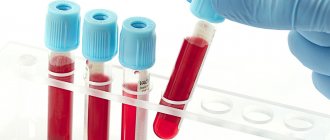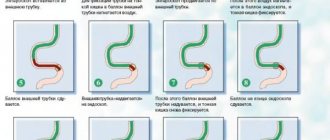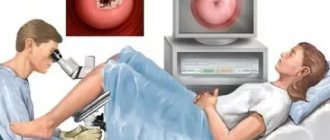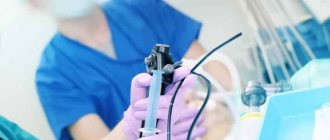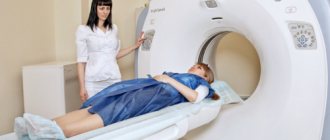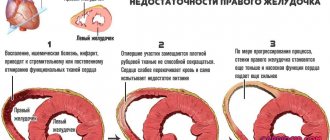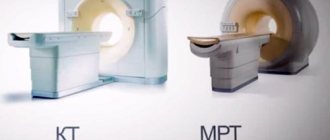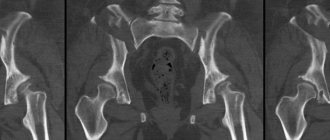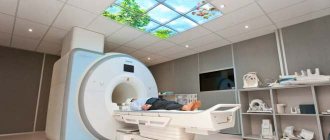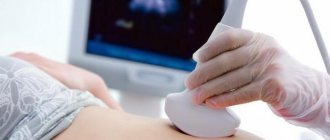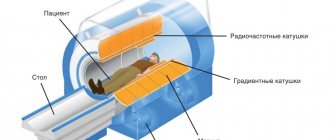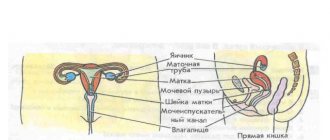5 / 5 ( 3 voices)
Despite the fact that information about medical research is not hidden, many potential patients still have difficulty familiarizing themselves with the procedures due to the complexity of medical equipment and the vagueness of doctors’ prescriptions. Therefore, the questions: “Is preparation required for gastroscopy of the stomach, and what should be done before the examination?” may remain undisclosed. In this regard, let us reveal the understatement.
What is FGS?
Fibrogastroscopy is a method for examining the gastrointestinal tract (gastrointestinal tract), carried out by introducing a special probe (endoscope) through the oral cavity. The purpose of this diagnosis is to find and study pathologies of the digestive organs. The procedure allows you to adjust the course of treatment, for which a sample (biopsy) of the damaged organ tissue is taken.
Decoding of the abbreviation FGS in medicine - “fibrogastroduodenoscopy”:
- “fibro” - flexible fiberscope;
- "gastro" - stomach;
- “Scopy” is a visual inspection.
Types of fibrogastroscopy
In gastroenterology, there are three methods of gastroscopy, the differences between which lie in the study of different parts of the gastrointestinal tract:
- FGS (fibrogastroscopy). This type of endoscopy is aimed at examining the stomach. During the procedure, the gastroenterologist examines the condition of the surface layer of the organ. The doctor may remove part of the stomach lining for a biopsy to look for malignant or benign tumors. The duration of the procedure is 10-15 minutes.
- FGDS (fibrogastroduodenoscopy). This endoscopic examination involves examining the stomach and duodenum. The specialist identifies foci of inflammation and pathology in the tissues of these organs, and also evaluates the quality of contractions of the sphincter located between them. The duration of the procedure is 15-20 minutes.
- EFGDS (esophagogastroduodenoscopy) or FEGDS (fibroesophagogastroduodenoscopy). This diagnosis is aimed at studying the three organs of the gastrointestinal tract together: the esophagus, stomach and duodenum. For this reason, unlike other gastroscopy methods, EGDS gives a more complete picture of the functioning of the gastrointestinal tract. It can last more than 30 minutes. During the examination, in addition to ulcers, erosions and other pathologies of the digestive organs, the presence of a gastrointestinal tumor can be detected.
What does FGDS mean?
FGDS is a method of examining the stomach.
What does this procedure include, based on its name:
- The word "fibro" implies a characteristic of the probe that is used in this procedure. It is made of optical fiber. A videoscope can also be used for research, with the help of which a photograph of the digestive tract organs will be displayed on the monitor.
- The name "gastro" implies an examination of the walls of the stomach.
- The word particle “duodeno” indicates that the study will be carried out on the duodenum, that is, the base of the intestine.
- The last prefix of the name “scopy” means that the doctor, using a probe, can examine the internal state of the abdominal organs.
- Also, this procedure may also be called fibroesophagogastroduodenoscopy. By the name of this procedure, you can indicate that the esophagus is also examined.
What can be checked for FGS
With the help of an examination, the condition of the gastrointestinal tract organs is checked, namely:
- esophagus;
- stomach;
- duodenum.
During gastroscopy, doctors evaluate:
- condition of the mucous membrane of the walls of the gastrointestinal tract;
- the amount of narrowing of the lumen of the esophagus;
- presence/absence of scars;
- degree of reflux (reflux of stomach contents into the esophagus);
- presence/absence of oncological neoplasms and tumors;
- presence/absence of peptic ulcer, gastritis;
- degree of patency in the gastrointestinal tract.
Esophagus
In the process of examining the esophagus using FGDS, three physiological narrowings are measured, which according to the norm should be:
- the first - at the beginning of the esophagus;
- the second - at the level of the bifurcation of the trachea;
- the third is at the place where the esophagus passes through the diaphragm.
The healthy state of the organ is indicated by:
- light pink color of its mucous membrane;
- absence of pathological changes (erosions or ulcers);
- smoothness of the walls of the organ;
- proper functioning of the sphincters: they must close completely, preventing the backflow of stomach contents into the esophagus.
Stomach
In normal condition, the stomach has:
- pale pink color;
- smooth walls without inflammation and ulcers;
- transparent and evenly covering the gastric folds secretion (mucus);
- smooth, without compactions, relief of the mucous membrane.
Duodenum
The duodenum of a healthy person has:
- velvety mucous membrane;
- gray pink color;
- evenly lumpy walls without inflammation or other pathologies.
Indications for FGS
Indications for which a physician can give a referral for fibrogastroscopy:
| Gastrointestinal pathology | Symptoms of the disease | Goals of the FGS |
| Ulcer (deep damage to the mucous membrane of the stomach and/or duodenum) |
|
|
| Polyps (growths that form as a result of abnormally overgrown tissue) | The appearance of polyps is not characterized by the manifestation of clinical symptoms. Most often, the pathology develops in adults. |
|
| Phlebeurysm | The onset of the disease is asymptomatic, but in the extreme stages of the disease the following appears:
|
|
| Gastroesophageal reflux disease (reflux of stomach contents into the esophagus) |
|
|
| Inflammation of the duodenal mucosa |
|
|
| Inflammation of the gastric mucosa |
|
|
| Inflammation of the esophageal mucosa (esophagitis) |
|
|
| Inflammation of the mucous membrane of the large intestine |
|
|
| Bleeding (may be a consequence of gastrointestinal cancer) |
|
|
Is gastroscopy of the stomach painful?
People feel fear when they see the tube and realize that they will have to swallow it. This is not surprising, because the gastroscope in the photo and in real life looks terrifying and even traumatic.
Gastroscope, a device for examining the stomach
In fact, the procedure is often performed under anesthesia (especially in private clinics). As a rule, a method is used with sedation and pain relief with special medications that immerse a person in the kingdom of Morpheus. In a dream, a person will be left with discomfort and fear, which can cause complications after gastroscopy. Local anesthesia or freezing of the throat is also used for pain relief.
The procedure can be done painlessly, but in the end the person will still feel discomfort, the sensation of a foreign body inside him. What you definitely shouldn’t be afraid of is damage to internal organs by the probe. A gastroscope is a soft tube designed in such a way that it simply cannot injure the patient’s organs and mucous membranes.
Contraindications
The main contraindications to performing FGDS:
- narrowing of the stomach or esophagus;
- rachiocampsis;
- goiter (enlarged thyroid gland);
- intestinal obstruction;
- atherosclerosis;
- severe stomach bleeding;
- mental illness in the acute stage;
- protrusion of the walls of the esophagus;
- cervical lymphadenitis (enlarged lymph nodes);
- aortic aneurysm;
- myocardial infarction;
- recent stroke;
- disturbances in the functioning of the heart;
- hypertensive crisis;
- exacerbation of bronchial asthma;
- pathologies of cerebral circulation;
- strong gag reflex;
- severe upper respiratory tract diseases;
- obesity;
- blood clotting disorder;
- colds;
- heat.
Before the examination, the doctor must warn in which cases the diagnosis is contraindicated. If the patient has at least one of the listed diseases, undergoing FGS can be dangerous to life and health.
In the video, a specialist from the “Medical” channel answers the most frequently asked questions about fibrogastroduodenoscopy.
Rules for preparing for the FGS
Basic rules for preparing for research:
- The procedure is carried out strictly on an empty stomach. Within 10-12 hours before FGS, you need to refuse food and any liquid (except water). You should also refrain from drinking any liquid 2 hours before the test. Otherwise, excessive secretion of gastric juice and the presence of food in the stomach will distort the examination results and also provoke vomiting.
- It is necessary to follow a diet. Dinner on the eve of a gastroscopic examination should be light and quickly digestible, and in addition, difficult-to-digest foods should be avoided for 1-2 days before the examination.
- You should not smoke for 4-5 hours before the examination. This is due to an increase in the secretory function of the gastric glands when smoking even one cigarette.
- You should avoid brushing your teeth and chewing gum on the day of the examination. These actions also lead to an increase in the secretion of gastric juice.
- If possible, you should stop taking medications. If the subject is taking medications, you must first consult with a doctor about the possibility of temporarily canceling them.
The patient must take with him to the FGS:
- direction;
- outpatient card (if available);
- shoe covers or replacement shoes;
- disposable diaper (place on the couch);
- towel (place under your head).
Before FGS, it is necessary to remove glasses or contact lenses and remove dentures.
FGDS - when not to do it
The FGDS procedure also has contraindications.
This examination cannot be carried out if the patient has a sore throat or has an acute respiratory disease. When is it necessary to sign up for an FGDS procedure:
- Body temperature remains at 38 degrees Celsius.
- Constant nausea, as well as vomiting, with which blood clots come out (in this situation, the color resembles dark chocolate).
- Defecation is difficult, and the stake is black (that is, there is a trace of blood in it).
- My stomach hurts all the time.
All this suggests that some abnormalities are developing in the body. To find out, you need to urgently visit a doctor who will prescribe this procedure.
Read along with this article:
- Preparation for FGDS of the stomach: features of the procedure required...
- FGDS of the stomach: preparation for the procedure
- Research was prescribed: FGDS - what is it?
- Fibrogastroduodenoscopy as a research method...
- How FGDS is done: preparation and conduct of the procedure
- How is an X-ray of the intestine done with contrast (with barium)
- What can be seen with magnetic resonance imaging of the stomach
- Fibrogastroscopy of the stomach: when is it necessary and how is it performed?
- Gastroscopy under anesthesia: features and contraindications
Methodology of the procedure
FGS is usually carried out by two people: an instrumental diagnostics doctor (or gastroenterologist) and a nurse. Before starting the examination, the doctor must check the serviceability of the medical equipment and study the direction. The nurse prepares the patient for the procedure and monitors the insertion of the probe during the examination.
Fibrogastroscopy is performed using an endoscope, which consists of the following components:
- Tip. It has a lamp and a camera that transmit the image to the monitor. Capable of rotating 180 degrees.
- A tube. Thin and flexible, its length is 1 meter. Equipped with special forceps for biopsy and other surgical procedures. There are also two channels inside it: supplying medicines and pumping air to straighten the folds of the stomach.
- Control device. Using it, you can rotate the tip of the endoscope, adjust the air flow and the brightness of the lighting. The process of taking material is started from it and the medicine is injected into the organ being examined.
How is the examination carried out?
Procedure for conducting FGS:
- The patient lies down on the couch and turns over onto his left side.
- The nurse inserts a mouthpiece into his mouth, and the patient clamps it with his teeth.
- The doctor gradually inserts the endoscope, examining the organs being examined.
- The image from the probe is transmitted to the monitor. Typically, the examination is carried out with video recording, this provides the opportunity for further analysis of the video material by a gastroenterologist.
- If necessary, therapeutic and diagnostic measures are carried out: biopsy, removal of a foreign body, application of clips to stop bleeding. In case of gastrointestinal cancer, such manipulations are coordinated with the attending physician, since accidental disruption of the integrity of a malignant tumor is dangerous to the patient’s health.
- At the end of the procedure, the probe is smoothly removed.
In exceptional cases, for example, if the patient is disabled and cannot be moved, FGS can be performed at home.
Duration of the procedure
Gastroscopy lasts from 10 to 30 minutes. The duration of the procedure may increase, it depends on how many therapeutic and diagnostic measures need to be performed. On average, additional manipulations, such as taking a biopsy or eliminating bleeding, should take no more than 5-10 minutes.
Features of behavior during the procedure
Compliance with the following rules will contribute to a successful examination:
- No need to be nervous and fuss. Excessive anxiety can provoke muscle tension, which will complicate the process of inserting the endoscope into the oral cavity.
- You cannot move during the procedure. This may increase the risk of damage to the mucous membrane of the gastrointestinal tract by the tube of the device.
- It is necessary to monitor your breathing. Doctors recommend exhaling air through your mouth as the endoscope moves deeper into the body. It is believed that this method of breathing will minimize discomfort and prevent vomiting.
- You cannot talk or swallow saliva. These actions are accompanied by movements of the esophagus, so they will interfere with specialists’ research.
How is gastroscopy done?
As mentioned earlier, the procedure is performed by trained doctors who are familiar with modern endoscopy equipment. Before starting the diagnosis, the patient's throat is treated with lidocaine spray. This is necessary to significantly reduce discomfort. Particularly fearful patients are put into a state of shallow sleep.
Further manipulations take place according to the following algorithm:
- the patient lies on his side, heals the mouthpiece (element of the gastroscope) with his lips and relaxes the throat;
- the doctor inserts a gastroscope tube into the patient’s throat;
- the air flow necessary to straighten the cavities of the gastrointestinal tract is supplied through the instrument;
- the specialist examines the desired organ (in this case, the stomach), and, if necessary, records data using photos or videos;
- also, for specific indications, material for a biopsy can be taken;
- After all the manipulations are completed, the gastroscope is removed.
During the examination, the patient may vomit. In order to avoid this, the patient needs to breathe calmly and deeply and try not to get nervous. If strong, unbearable vomiting occurs, the diagnosis is stopped.
How long does it take?
Intermediate procedures can be performed: stopping bleeding, removing polyps, measuring acidity in the gastrointestinal tract. In such situations, the examination will take longer, but usually it lasts about 2-4 minutes.
In case of internal bleeding, the procedure can be performed while standing.
Advantages and disadvantages of the survey
The main advantages of FGS are:
- high information content;
- good image quality;
- no radiation (unlike x-rays);
- short duration of the study;
- quick results.
Disadvantages of FGS:
- discomfort during the procedure;
- belching and heaviness in the stomach after the examination (judging by patient reviews, this is one of the most common consequences of the examination);
- there is a small risk of side effects (damage to the duodenum by the endoscope, microtrauma to the stomach, esophagus, infection in the gastrointestinal tract);
- complications are possible (for example, bleeding after an unsuccessful biopsy).
Is gastroscopy harmful?
Gastroscopy may be harmful in some cases. As a rule, complications appear not due to injury to the gastrointestinal tract and in particular the stomach, but due to problems with the heart (due to severe fear) and the respiratory system. According to research, only 1 percent of patients require immediate medical attention after undergoing gastroscopy. Complications are observed in people with severe lung diseases, acute heart failure, and a tendency to bleeding.
Complications after gastroscopy may occur if you have severe kidney disease
Possible complications
Complications after FGS:
| Complication | Cause | Registration frequency |
| Bleeding | The endoscope damaged the mucous membrane of an organ or its vessels | Rarely |
| Asphyxia | Insufficient preparation of the patient for the procedure, ignoring the doctor’s recommendations | Very rarely |
| Aspiration pneumonia | Eating food immediately before the examination | Very rarely |
| Stomach ache | Injuring the walls of an organ with an endoscope, taking a biopsy | Sometimes |
According to statistics, only 1 patient out of 100 experiences negative consequences from fibrogastroscopy.
Decoding the results
Interpretation of the results of this gastrological examination:
- Esophagus. The examination report contains information about what the organ looks like. For example, the presence of reddish areas on the walls of the esophagus are clear signs of inflammation. Thickening of organ tissue indicates the development of neoplasms; it is necessary to clarify this diagnosis with the help of additional tests.
- Stomach. The presence of white crater-shaped inclusions means the development of a peptic ulcer of the organ. Seals in the structure of the stomach are one of the main signs of an incipient oncological process. If FGS reveals cancer, the study protocol will describe the size, shape and location of the tumor.
- Duodenum. By analogy with the esophagus and stomach, normal diagnostics should not show thickenings and bright inclusions in the walls of the organ. Also, based on the picture obtained during the diagnosis, the specialist examines the nature of intestinal motility: it can be normal or slow.
The results of the study are deciphered by the diagnostician who performed the FGS. However, only the attending physician who ordered the examination can make a correct diagnosis.
Video
The video describes the features of the FGS. This video is posted on Katerina Khramtsova’s channel.
Do you have any questions? Specialists and readers of the HROMOSOMA website will help you ask a question
Was this article helpful?
Thank you for your opinion!
The article was useful. Please share the information with your friends.
Yes (100.00%)
No
X
Please write what is wrong and leave recommendations on the article
Cancel reply
Rate the benefit of the article: Rate the author ( 2 votes, average: 5.00 out of 5)
Discuss the article:
